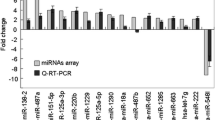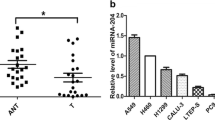Abstract
MicroRNA-200a (miR-200a) has been reported to regulate tumour progression in several tumours; however, little is known about its role in non-small cell lung cancer cells (NSCLCs). Here, we found that miR-200a was up-regulated in A549 and SK-MES-1 cells compared with normal lung cells HELF. By a series of gain-of-function and loss-of-function studies, over-expression of miR-200a was indicated to enhance cells migration, and its knock-down inhibited migration of cells in NSCLC cell lines. Furthermore, miR-200a was identified to induce TSPAN1 expression which was related to migration. TSPAN1 was proved to induce migration, and so up-regulation of TSPAN1 by miR-200a may explain why over-expressing miR-200a promotes NSCLC cells migration.






Similar content being viewed by others
References
Bendoraite A, Knouf EC, Garg KS, Parkin RK, Kroh EM, O'Briant KC, Ventura AP, et al. 2010 Regulation of miR-200 family microRNAs and ZEB transcription factors in ovarian cancer: evidence supporting a mesothelial-to-epithelial transition. Gynecol. Oncol. 116 117–125
Borczuk AC, Gorenstein L, Walter KL, Assaad AA, Wang L and Powell CA 2003 Non-small-cell lung cancer molecular signatures recapitulate lung developmental pathways. Am. J. Pathol. 163 1949–1960
Bracken CP, Gregory PA, Khew-Goodall Y and Goodall GJ 2009 The role of microRNAs in metastasis and epithelial-mesenchymal transition. Cell Mol. Life Sci. 66 1682–1699
Calbó J, Meuwissen R, van Montfort E, van Tellingen O and Berns A 2005 Genotype-phenotype relationships in a mouse model for human small-cell lung cancer. Cold Spring Harb. Symp. Quart. Biol. 70 225–232
Ceppi P, Mudduluru G, Kumarswamy R, Rapa I, Scagliotti GV, Papotti M and Allgayer H 2010 Loss of miR-200c expression induces an aggressive, invasive, and chemoresistant phenotype in non-small cell lung cancer. Mol. Cancer Res. 8 1207–1216
Chan YC , Khanna S, Roy S and Sen CK 2011 miR-200b targets Ets-1 and is down-regulated by hypoxia to induce angiogenic response of endothelial cells. J. Biol. Chem. 286 2047–2056
Chen L, Wang Z, Zhan X, Li DC, Zhu YY and Zhu J 2007 Association of NET-1 gene expression with human hepatocellular carcinoma. Int. J. Surg. Pathol. 15 346–353
Chen L, Li X, Wang GL, Wang Y, Zhu YY and Zhu J 2008 Clinicopathological significance of overexpression of TSPAN1, Ki67 and CD34 in gastric carcinoma. Tumori 94 531–538
Chen L, Zhu YY, Zhang XJ, Wang GL, Li XY, He S, Zhang JB and Zhu JW 2009 TSPAN1 protein expression: a significant prognostic indicator for patients with colorectal adenocarcinoma. World J. Gastroenterol. 15 2270–2276
Chen L, Yuan D, Zhao R, Li H, Zhu J 2010a Suppression of TSPAN1 by RNA interference inhibits proliferation and invasion of colon cancer cells in vitro. Tumori 96 744–750
Chen L, Zhu YY, Li H, Wang GL, Wu YY, Lu YX, Qin J, Tuo J, Wang JL and Zhu J 2010b Knockdown of TSPAN1 by RNA silencing and antisense technique inhibits proliferation and infiltration of human skin squamous carcinoma cells. Tumori 96 289–295
Elson-Schwab I, Lorentzen A and Marshall CJ 2010 MicroRNA-200 family members differentially regulate morphological plasticity and mode of melanoma cell invasion. PLoS One 5 e13176
Granville CA and Dennis PA 2005 An overview of lung cancer genomics and proteomics. Am. J. Respir. Cell Mol. Biol. 32 169–176
Gregory PA, Bert AG, Paterson EL, Barry SC, Tsykin A, Farshid G, Vadas MA, Khew-Goodall Y and Goodall GJ 2008 The miR-200 family and miR-205 regulate epithelial to mesenchymal transition by targeting ZEB1 and SIP1. Nat. Cell Biol. 10 593–601
Hung CS, Liu HH, Liu JJ, Yeh CT, Chang TC, Wu CH, Ho YS, Wei PL and Chang YJ 2012 MicroRNA-200a and -200b mediated hepatocellular carcinoma cell migration through the epithelial to mesenchymal transition markers. Ann. Surg. Oncol.
Iliopoulos D, Lindahl-Allen M, Polytarchou C, Hirsch HA, Tsichlis PN and Struhl K 2010 Loss of miR-200 inhibition of Suz12 leads to polycomb-mediated repression required for the formation and maintenance of cancer stem cells. Mol. Cell 39 761–772
Jiang L, Huang Q, Zhang S, Zhang Q, Chang J, Qiu X and Wang E 2010 Hsa-miR-125a-3p and hsa-miR-125a-5p are downregulated in non-small cell lung cancer and have inverse effects on invasion and migration of lung cancer cells. BMC Cancer 10 318
Jiang YL and Liu ZP 2011 Natural Products as Anti-Invasive and Anti-Metastatic Agents. Curr. Med. Chem. 18 808–829
Korpal M, Ell BJ, Buffa FM, Ibrahim T, Blanco MA, Celià-Terrassa T, Mercatali L, Khan Z, et al. 2011 Direct targeting of Sec23a by miR-200s influences cancer cell secretome and promotes metastatic colonization. Nat. Med. 17 1101–1108
Korpal M and Kang YB 2008 The emerging role of miR-200 family of microRNAs in epithelial-mesenchymal transition and cancer metastasis. RNA Biol. 5 115–119
Lee HY, Chung JK, Jeong JM, Lee DS, Kim DG, Jung HW and Lee MC 2008 Comparison of FDG-PET fingings of brain metastasis from non-small-cell lung cancer and small-cell lung cancer. Ann. Nuclear Med. 22 281–286
Lee JW, Park YA, Choi JJ, Lee YY, Kim CJ, Choi C, Kim TJ, Lee NW, Kim BG and Bae DS 2011 The expression of the miRNA-200 family in endometrial endometrioid carcinoma. Gynecol. Oncol. 120 56–62
Majid S, Dar AA, Saini S, Yamamura S, Hirata H, Tanaka Y, Deng G and Dahiya R 2010 MicroRNA-205-directed transcriptional activation of tumor suppressor genes in prostate cancer. Cancer 116 5637–5649
Park SM, Gaur AB, Lengyel E and Peter ME 2008 The miR-200 family determines the epithelial phenotype of cancer cells by targeting the E-cadherin repressors ZEB1 and ZEB2. Genes Dev. 22 894–907
Perry SM and Anil KR 2010 The role of the miR-200 family in epithelial- mesenchymal transition. Cancer Biol. Ther. 10 219–222
Place RF, Li LC, Pookot D, Noonan EJ and Dahiya R 2008 MicroRNA-373 induces expression of genes with complementary promoter sequences. PNAS 105 1608–1613
Pontes O and Pikaard CS 2008 siRNA and miRNA processing: new functions for Cajal bodies. Curr. Opin. Gene Dev. 18 197–203
Roybal JD, Zang Y, Ahn YH, Yang Y, Gibbons DL, Baird BN, Alvarez C, Thilaganathan N, et al. 2011 miR-200 Inhibits lung adenocarcinoma cell invasion and metastasis by targeting Flt1/VEGFR1. Mol. Cancer Res. 9 25–35
Saydam O, Shen Y, Würdinger T, Senol O, Boke E, James MF, Tannous BA, Stemmer-Rachamimov AO, et al. 2009 Down-regulated microRNA-200a in meningiomas promotes tumor growth by reducing E-cadherin and activating the Wnt/β catenin signaling pathway. Mol. Cell Biol. 29 5923–5940
Schaefer A, Jung M, Mollenkopf HJ, Wagner I, Stephan C, Jentzmik F, Miller K, Lein M, Kristiansen G and Jung K 2010 Diagnostic and prognostic implications of microRNA profiling in prostate carcinoma. Int. J. Cancer 126 1166–1176
Scholz CJ, Kurzeder C, Koretz K, Windisch J, Kreienberg R, Sauer G and Deissler H 2009 Tspan-1 is a tetraspanin preferentially expressed by mucinous and endometrioid subtypes of human ovarian carcinomas. Cancer Lett. 275 198–203
Szczyrba J, Löprich E, Wach S, Jung V, Unteregger G, Barth S, Grobholz R, Wieland W, et al. 2010 The microRNA profile of prostate carcinoma obtained by deep sequencing. Mol. Cancer Res. 8 529–538
Uhlmann S, Zhang JD, Schwäger A, Mannsperger H, Riazalhosseini Y, Burmester S, Ward A, Korf U, Wiemann S and Sahin O 2010 miR-200bc/429 cluster targets PLCgamma1 and differentially regulates proliferation and EGF-driven invasion than miR-200a/141 in breast cancer. Oncogene 29 4297–4306
Ventura A and Jacks T 2009 MicroRNAs and cancer: Short RNAs go a long way. Cell 136 586–591
Wang XC, Tian LL, Wu HL, Jiang XY, Du LQ, Zhang H, Wang YY, Wu HY, et al. 2010 Expression of miRNA-130a in nonsmall cell lung cancer. Am. J. Med. Sci. 340 385–388
Woo IS, Park MJ, Byun JH, Hong YS, Lee KS, Park YS, Lee JA, Park YI and Ahn HK 2004 Expression of placental growth factor gene in lung cancer. Tumour Biol. 25 1–6
Xia H, Ng SS, Jiang S, Cheung WK, Sze J, Bian XW, Kung HF and Lin MC 2009 miR-200a-mediated downregulation of ZEB2 and CTNNB1 differentially inhibits nasopharyngeal carcinoma cell growth, migration and invasion. Biochem. Biophys. Res. Commun. 391 535–541
Xia H, Cheung WK, Sze J, Lu G, Jiang S, Yao H, Bian XW, Poon WS, Kung HF and Lin MC 2010 miR-200a regulates epithelial-mesenchymal to stem-like transition via ZEB2 and beta-catenin signaling. J. Biol. Chem. 285 36995–37004
Yu SL, Chen HY, Chang GC, Chen CY, Chen HW, Singh S, Cheng CL, Yu CJ, et al. 2008 MicroRNA signature predicts survival and relapse in lung cancer. Cell 13 48–57
Zhang JG, Wang JJ, Zhao F, Liu Q, Jiang K and Yang GH 2010 MicroRNA-21 (miR-21) represses tumor suppressor PTEN and promotes growth and invasion in non-small cell lung cancer (NSCLC). Clin. Chim. Acta. 411 846–852
Acknowledgements
We thank Professor Chen Li (Nantong University, Jiangsu, China) for providing TSPAN1 antibody and valuable suggestions on technology.
Author information
Authors and Affiliations
Corresponding authors
Additional information
Corresponding editor: VEENA K PARNAIK
MS received 25 February 2013; accepted 17 June 2013
Corresponding editor: Veena K Parnaik
[Chen Y, Peng W, Lu Y, Chen J, Zhu YY And Xi T 2013 MiR-200a enhances the migrations of A549 and SK-MES-1 cells by regulating the expression of TSPAN1. J. Biosci. 38 1–10] DOI 10.1007/s12038-013-9351-6
Rights and permissions
About this article
Cite this article
Chen, Y., Peng, W., Lu, Y. et al. MiR-200a enhances the migrations of A549 and SK-MES-1 cells by regulating the expression of TSPAN1. J Biosci 38, 523–532 (2013). https://doi.org/10.1007/s12038-013-9351-6
Received:
Accepted:
Published:
Issue Date:
DOI: https://doi.org/10.1007/s12038-013-9351-6




